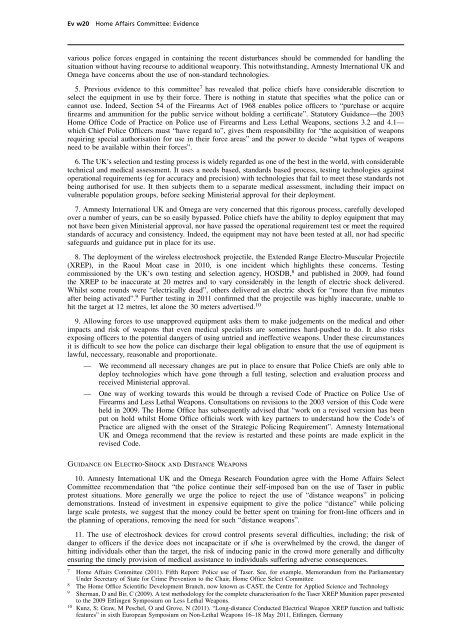Policing Large Scale Disorder: Lessons from the disturbances of ...
Policing Large Scale Disorder: Lessons from the disturbances of ...
Policing Large Scale Disorder: Lessons from the disturbances of ...
Create successful ePaper yourself
Turn your PDF publications into a flip-book with our unique Google optimized e-Paper software.
Ev w20 Home Affairs Committee: Evidence<br />
various police forces engaged in containing <strong>the</strong> recent <strong>disturbances</strong> should be commended for handling <strong>the</strong><br />
situation without having recourse to additional weaponry. This notwithstanding, Amnesty International UK and<br />
Omega have concerns about <strong>the</strong> use <strong>of</strong> non-standard technologies.<br />
5. Previous evidence to this committee 7 has revealed that police chiefs have considerable discretion to<br />
select <strong>the</strong> equipment in use by <strong>the</strong>ir force. There is nothing in statute that specifies what <strong>the</strong> police can or<br />
cannot use. Indeed, Section 54 <strong>of</strong> <strong>the</strong> Firearms Act <strong>of</strong> 1968 enables police <strong>of</strong>ficers to “purchase or acquire<br />
firearms and ammunition for <strong>the</strong> public service without holding a certificate”. Statutory Guidance—<strong>the</strong> 2003<br />
Home Office Code <strong>of</strong> Practice on Police use <strong>of</strong> Firearms and Less Lethal Weapons, sections 3.2 and 4.1—<br />
which Chief Police Officers must “have regard to”, gives <strong>the</strong>m responsibility for “<strong>the</strong> acquisition <strong>of</strong> weapons<br />
requiring special authorisation for use in <strong>the</strong>ir force areas” and <strong>the</strong> power to decide “what types <strong>of</strong> weapons<br />
need to be available within <strong>the</strong>ir forces”.<br />
6. The UK’s selection and testing process is widely regarded as one <strong>of</strong> <strong>the</strong> best in <strong>the</strong> world, with considerable<br />
technical and medical assessment. It uses a needs based, standards based process, testing technologies against<br />
operational requirements (eg for accuracy and precision) with technologies that fail to meet <strong>the</strong>se standards not<br />
being authorised for use. It <strong>the</strong>n subjects <strong>the</strong>m to a separate medical assessment, including <strong>the</strong>ir impact on<br />
vulnerable population groups, before seeking Ministerial approval for <strong>the</strong>ir deployment.<br />
7. Amnesty International UK and Omega are very concerned that this rigorous process, carefully developed<br />
over a number <strong>of</strong> years, can be so easily bypassed. Police chiefs have <strong>the</strong> ability to deploy equipment that may<br />
not have been given Ministerial approval, nor have passed <strong>the</strong> operational requirement test or meet <strong>the</strong> required<br />
standards <strong>of</strong> accuracy and consistency. Indeed, <strong>the</strong> equipment may not have been tested at all, nor had specific<br />
safeguards and guidance put in place for its use.<br />
8. The deployment <strong>of</strong> <strong>the</strong> wireless electroshock projectile, <strong>the</strong> Extended Range Electro-Muscular Projectile<br />
(XREP), in <strong>the</strong> Raoul Moat case in 2010, is one incident which highlights <strong>the</strong>se concerns. Testing<br />
commissioned by <strong>the</strong> UK’s own testing and selection agency, HOSDB, 8 and published in 2009, had found<br />
<strong>the</strong> XREP to be inaccurate at 20 metres and to vary considerably in <strong>the</strong> length <strong>of</strong> electric shock delivered.<br />
Whilst some rounds were “electrically dead”, o<strong>the</strong>rs delivered an electric shock for “more than five minutes<br />
after being activated”. 9 Fur<strong>the</strong>r testing in 2011 confirmed that <strong>the</strong> projectile was highly inaccurate, unable to<br />
hit <strong>the</strong> target at 12 metres, let alone <strong>the</strong> 30 meters advertised. 10<br />
9. Allowing forces to use unapproved equipment asks <strong>the</strong>m to make judgements on <strong>the</strong> medical and o<strong>the</strong>r<br />
impacts and risk <strong>of</strong> weapons that even medical specialists are sometimes hard-pushed to do. It also risks<br />
exposing <strong>of</strong>ficers to <strong>the</strong> potential dangers <strong>of</strong> using untried and ineffective weapons. Under <strong>the</strong>se circumstances<br />
it is difficult to see how <strong>the</strong> police can discharge <strong>the</strong>ir legal obligation to ensure that <strong>the</strong> use <strong>of</strong> equipment is<br />
lawful, neccessary, reasonable and proportionate.<br />
— We recommend all necessary changes are put in place to ensure that Police Chiefs are only able to<br />
deploy technologies which have gone through a full testing, selection and evaluation process and<br />
received Ministerial approval.<br />
— One way <strong>of</strong> working towards this would be through a revised Code <strong>of</strong> Practice on Police Use <strong>of</strong><br />
Firearms and Less Lethal Weapons. Consultations on revisions to <strong>the</strong> 2003 version <strong>of</strong> this Code were<br />
held in 2009. The Home Office has subsequently advised that “work on a revised version has been<br />
put on hold whilst Home Office <strong>of</strong>ficials work with key partners to understand how <strong>the</strong> Code’s <strong>of</strong><br />
Practice are aligned with <strong>the</strong> onset <strong>of</strong> <strong>the</strong> Strategic <strong>Policing</strong> Requirement”. Amnesty International<br />
UK and Omega recommend that <strong>the</strong> review is restarted and <strong>the</strong>se points are made explicit in <strong>the</strong><br />
revised Code.<br />
Guidance on Electro-Shock and Distance Weapons<br />
10. Amnesty International UK and <strong>the</strong> Omega Research Foundation agree with <strong>the</strong> Home Affairs Select<br />
Committee recommendation that “<strong>the</strong> police continue <strong>the</strong>ir self-imposed ban on <strong>the</strong> use <strong>of</strong> Taser in public<br />
protest situations. More generally we urge <strong>the</strong> police to reject <strong>the</strong> use <strong>of</strong> “distance weapons” in policing<br />
demonstrations. Instead <strong>of</strong> investment in expensive equipment to give <strong>the</strong> police “distance” while policing<br />
large scale protests, we suggest that <strong>the</strong> money could be better spent on training for front-line <strong>of</strong>ficers and in<br />
<strong>the</strong> planning <strong>of</strong> operations, removing <strong>the</strong> need for such “distance weapons”.<br />
11. The use <strong>of</strong> electroshock devices for crowd control presents several difficulties, including; <strong>the</strong> risk <strong>of</strong><br />
danger to <strong>of</strong>ficers if <strong>the</strong> device does not incapacitate or if s/he is overwhelmed by <strong>the</strong> crowd, <strong>the</strong> danger <strong>of</strong><br />
hitting individuals o<strong>the</strong>r than <strong>the</strong> target, <strong>the</strong> risk <strong>of</strong> inducing panic in <strong>the</strong> crowd more generally and difficulty<br />
ensuring <strong>the</strong> timely provision <strong>of</strong> medical assistance to individuals suffering adverse consequences.<br />
7 Home Affairs Committee (2011). Fifth Report: Police use <strong>of</strong> Taser. See, for example, Memorandum <strong>from</strong> <strong>the</strong> Parliamentary<br />
Under Secretary <strong>of</strong> State for Crime Prevention to <strong>the</strong> Chair, Home Office Select Committee<br />
8 The Home Office Scientific Development Branch, now known as CAST, <strong>the</strong> Centre for Applied Science and Technology<br />
9 Sherman, D and Bir, C (2009). A test methodology for <strong>the</strong> complete characterisation fo <strong>the</strong> Taser XREP Munition paper presented<br />
to <strong>the</strong> 2009 Ettlingen Symposium on Less Lethal Weapons.<br />
10 Kunz, S; Graw, M Peschel, O and Grove, N (2011). “Long-distance Conducted Electrical Weapon XREP function and ballistic<br />
features” in sixth European Symposium on Non-Lethal Weapons 16–18 May 2011, Ettlingen, Germany
















